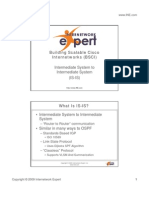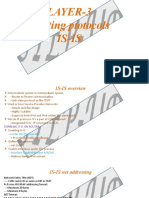0 ratings0% found this document useful (0 votes)
225 viewsISIS Routing Protocol Note - Intermediate Systems To Intermediate Systems
IS-IS is a link-state interior gateway protocol similar to OSPF. It is commonly used in service provider core networks due to its simple flat network design and high scalability. IS-IS forms both level 1 and level 2 adjacencies by default and uses two levels to separate intra-area and inter-area routing. Route leaking allows selective distribution of routes between levels to influence traffic engineering.
Uploaded by
Ayub PrasetyoCopyright
© © All Rights Reserved
Available Formats
Download as PDF, TXT or read online on Scribd
0 ratings0% found this document useful (0 votes)
225 viewsISIS Routing Protocol Note - Intermediate Systems To Intermediate Systems
IS-IS is a link-state interior gateway protocol similar to OSPF. It is commonly used in service provider core networks due to its simple flat network design and high scalability. IS-IS forms both level 1 and level 2 adjacencies by default and uses two levels to separate intra-area and inter-area routing. Route leaking allows selective distribution of routes between levels to influence traffic engineering.
Uploaded by
Ayub PrasetyoCopyright
© © All Rights Reserved
Available Formats
Download as PDF, TXT or read online on Scribd
You are on page 1/ 4
Link state IGP similiar to OSPF, OSPF for IP and ISIS for CLNS.
then developed to support IPv4 and IPv6.
Used in SP Core, less feature compared to EIGRP and OSPF but most
suitable with SP due to :
simply flat network design
Carriers and ISPs run BGP-based networks, and their
IGP is used mainly for finding BGP session endpoints. So they want their
IGP to be as simple as possibleoften making their entire routing
domain a single IGP area. IS-IS is certainly simpler than OSPF in many
aspects, and many will argue that it is more scalable in this type of
single large area application. So when you encounter IS-IS in a service
provider network, what you will usually encounter is a single L2
area. Jeff Doyle (Routing TCP IP Volume 1)
highly scalable
Remaining lifetime, is an age of LSP. IS-IS Remaining Lifetime begins at
MaxAge and decrement to Zerowhereas OSPF LSAs Age increment from
zero to MaxAge.
default IS-IS Maxages is 1200s (20Mnutes), and IS-IS refresh interval is 15
minutes.because IS-IS remaining lifetimes begins with non zero number
and is decrement to zero.
the beginning number can be set from its default 1200s (20minutes) , to
maximum
65535 second (18.2Hours).
this is major contributing factor to IS-IS scalability in very large areas. If
the area links are reasonably stable, increasing the refresh time and the
Remaining Lifetime can sharply reduce the flooding load caused
by LSP refreshes. Jeff Doyle
support ipv4 and ipv6 routing
Enabling ISIS on IOS :
-enable process globally
{router isis [process id]}
-define NET address
{net [nsap]}
-enable in interface process
{ip router isis [process id]}
Enabling ISIS on IOS XR :
-enable process globally
{router isis [process id]}
-define NET address
{net [nsap]}
-enable interfaces under IS-IS process
{interface gig0/1/0/4
address-family ipv4 unicast}
NET (Network Entity Title)
isis router id
use ISO NSAP addressing format, minimum 8 bytes maximum 20bytes
NET Format :
AA.AAAA.AAAA.AAAA.AAAA.AAAA.AAAA.SSSS.SSSS.SSSS.NN
Area not like ospf area
System ID Router ID Inside the Area
N-Selector always zero.
49.xxxx (49) in NSAP is like private address
IS-IS Adjacency Levels
-ISIS uses two levels of adjacency
Level 1 (L1)
Level 2 (L2)
-Process and Interface default to Level-1-2
Forms both L1 and L2
Separate LSP Database, Double the overhead
-Commonly in Service provider core, we only use single level of adjacency
or (ospf single area) because
mpls ldp and traffic engineering limitations
L2 Adjacency
-Inter or Inra area adjacency
-Like area 0 in OSPF
-Must be Contiguous
L1 Adjacecny
-Intra area adjacency only
-Like OSPF Not So Stubby Area
Intra area routes
Default route out
redistribution allowed
Router Roles
L1-L2 Routing
-Like ABR in OSPF
used as exit point from L1 to L2
-Inject default route to level-1
Sets the attached bit (only if its connected to different area, will not
advertise default route even its L1L2 router if all of its interface are in
same area)
Level Manipulation
used to utilize isis database
global under isis process, affect all interfaces
is-type
under interface configuration, affect only that interfaces
isis circuit-type
ISIS Network type, path selection and Route leaking
ISIS have only 2 network type :
broadcast (ethernet)
default on multipoint interfaaces
uses DIS instead of DR/BDR
can be seen from show isis neighbor the circuit id indicated the DIS on
the segment
LSP are multicast
point to point
default on point to point interfaces
change network type
isis network point-to-point
point to point uses (serial IIH) and broadcast uses (L2/L1 LAN IIH),
incompatible with one another.
DIS election
like ospf dr/bdr
no backup DIS
election is dynamic, preemption can occur
separate elction for L1 and L2
occur by :
highest prioirity (default 64)
highest snpa (mac address)
best practice
any segment that only have 2 routers, we can just change the network to
only point to point
DIS only needed on segment with 3 or more router
ISIS path selection
isis doesnt use bandwidth metric as ospf does,
all link defualt to cost 10
can be manually modified
neighbor must agree on metric style
control how the actual metric is encoded on the updates / TLV (type link
value)
isis support 2 different metric style :
narrow (default), metric 1-63
wide (support more numerical value of cost, and also needed for enhance
application like mpls te), metric 1-16777214
incompatible with one another, the adjacency is up but the routes will
not installed on routing table
level 1 paths are preffered over level 2 paths, like ospf intra area routes
that preffered over inter area routes
IS-IS route leaking
selectively take level-2 routes and pass the into level-1 or filter level-1
routes as they move into level-2
level 2 domain know all prefixes
level 1 domain only know L1 prefixes
route leaking used for traffic engineering based on longest match prefix (i
ia)
configuration
IOS :
redistribute isis ip level-2 into level-1 (distribute-list/route-map)
IOS XR :
You might also like
- IP Routing Protocols All-in-one: OSPF EIGRP IS-IS BGP Hands-on LabsFrom EverandIP Routing Protocols All-in-one: OSPF EIGRP IS-IS BGP Hands-on LabsNo ratings yet
- Cisco Live - IsIS Deployment in Mordern NetworksNo ratings yetCisco Live - IsIS Deployment in Mordern Networks94 pages
- Intermediate System to Intermediate SystemNo ratings yetIntermediate System to Intermediate System7 pages
- Building Scalable Cisco Internetworks (BSCI)No ratings yetBuilding Scalable Cisco Internetworks (BSCI)21 pages
- Implementing is-Is - Student Learning Guide v4.2 - DOCXNo ratings yetImplementing is-Is - Student Learning Guide v4.2 - DOCX59 pages
- Big Little Book On IS-IS - IS-IS Refresh in Minutes100% (1)Big Little Book On IS-IS - IS-IS Refresh in Minutes29 pages
- Universidad Politecnica Salesiana: Electronics Engineerign ProgrameNo ratings yetUniversidad Politecnica Salesiana: Electronics Engineerign Programe3 pages
- HCIP Routing Switching IERS V2.5 Training Materials - pdf-136-168No ratings yetHCIP Routing Switching IERS V2.5 Training Materials - pdf-136-16833 pages
- APRICOT2014 - IsIS Fundamentals and TroubleshootingNo ratings yetAPRICOT2014 - IsIS Fundamentals and Troubleshooting110 pages
- CNE Lec7 Network layer - Routing_ MultiAreaOSPFNo ratings yetCNE Lec7 Network layer - Routing_ MultiAreaOSPF67 pages
- Multi-Area OSPF and Route Summarization: The Bryant Advantage CCNP ROUTE Study GuideNo ratings yetMulti-Area OSPF and Route Summarization: The Bryant Advantage CCNP ROUTE Study Guide32 pages
- Implementing IS-IS Over IPv6 On IOS-XE and IOS-XRNo ratings yetImplementing IS-IS Over IPv6 On IOS-XE and IOS-XR14 pages
- IGP Interview Questions for CCNA and CCNP EngineersNo ratings yetIGP Interview Questions for CCNA and CCNP Engineers11 pages
- In Depth Guide to IS-IS Routing: Learn Intermediate System to Intermediate System Routing from scratchFrom EverandIn Depth Guide to IS-IS Routing: Learn Intermediate System to Intermediate System Routing from scratchNo ratings yet
- CSE 4512 Computer Networks-Lab 06 - ManualNo ratings yetCSE 4512 Computer Networks-Lab 06 - Manual11 pages
- Introduction to OSPF - Lecture slides-2024No ratings yetIntroduction to OSPF - Lecture slides-202428 pages
- ROUTING INFORMATION PROTOCOL: RIP DYNAMIC ROUTING LAB CONFIGURATIONFrom EverandROUTING INFORMATION PROTOCOL: RIP DYNAMIC ROUTING LAB CONFIGURATIONNo ratings yet
- AXIS P5676-LE PTZ Camera: High-Performance 4 MP PTZ With IRNo ratings yetAXIS P5676-LE PTZ Camera: High-Performance 4 MP PTZ With IR3 pages
- FTP File Transfer Protocol: Reference: RFC 959No ratings yetFTP File Transfer Protocol: Reference: RFC 95915 pages
- TCP/IP Protocol Architecture: Network Interface LayerNo ratings yetTCP/IP Protocol Architecture: Network Interface Layer3 pages
- Huawei HSS9820 V900R009C01 Feature DescriptionNo ratings yetHuawei HSS9820 V900R009C01 Feature Description91 pages
- Datasheet Axis f9114 Main Unit en US 432166No ratings yetDatasheet Axis f9114 Main Unit en US 4321663 pages
- 3.2.2.4 Packet Tracer - Configuring Trunks InstructionsNo ratings yet3.2.2.4 Packet Tracer - Configuring Trunks Instructions2 pages
- Darktrace VSensors and Amazon VPC MirroringNo ratings yetDarktrace VSensors and Amazon VPC Mirroring15 pages
- New Examzoon Cisco-300-320 Dumps - Designing Cisco Network Service ArchitecturesNo ratings yetNew Examzoon Cisco-300-320 Dumps - Designing Cisco Network Service Architectures7 pages
- CCNA Security: Chapter Two Securing Network DevicesNo ratings yetCCNA Security: Chapter Two Securing Network Devices70 pages
- Multicast Design Solutions - Multicast-Enabled Clinical Networks - Cisco Press Book ChapterNo ratings yetMulticast Design Solutions - Multicast-Enabled Clinical Networks - Cisco Press Book Chapter37 pages
- Are POP and POP3 The Same Thing?: Client-Server ModelNo ratings yetAre POP and POP3 The Same Thing?: Client-Server Model6 pages
- IP Routing Protocols All-in-one: OSPF EIGRP IS-IS BGP Hands-on LabsFrom EverandIP Routing Protocols All-in-one: OSPF EIGRP IS-IS BGP Hands-on Labs
- Implementing is-Is - Student Learning Guide v4.2 - DOCXImplementing is-Is - Student Learning Guide v4.2 - DOCX
- Big Little Book On IS-IS - IS-IS Refresh in MinutesBig Little Book On IS-IS - IS-IS Refresh in Minutes
- Universidad Politecnica Salesiana: Electronics Engineerign ProgrameUniversidad Politecnica Salesiana: Electronics Engineerign Programe
- HCIP Routing Switching IERS V2.5 Training Materials - pdf-136-168HCIP Routing Switching IERS V2.5 Training Materials - pdf-136-168
- APRICOT2014 - IsIS Fundamentals and TroubleshootingAPRICOT2014 - IsIS Fundamentals and Troubleshooting
- Multi-Area OSPF and Route Summarization: The Bryant Advantage CCNP ROUTE Study GuideMulti-Area OSPF and Route Summarization: The Bryant Advantage CCNP ROUTE Study Guide
- IGP Interview Questions for CCNA and CCNP EngineersIGP Interview Questions for CCNA and CCNP Engineers
- In Depth Guide to IS-IS Routing: Learn Intermediate System to Intermediate System Routing from scratchFrom EverandIn Depth Guide to IS-IS Routing: Learn Intermediate System to Intermediate System Routing from scratch
- ROUTING INFORMATION PROTOCOL: RIP DYNAMIC ROUTING LAB CONFIGURATIONFrom EverandROUTING INFORMATION PROTOCOL: RIP DYNAMIC ROUTING LAB CONFIGURATION
- First Hop Redundancy Protocol: Network Redundancy ProtocolFrom EverandFirst Hop Redundancy Protocol: Network Redundancy Protocol
- AXIS P5676-LE PTZ Camera: High-Performance 4 MP PTZ With IRAXIS P5676-LE PTZ Camera: High-Performance 4 MP PTZ With IR
- TCP/IP Protocol Architecture: Network Interface LayerTCP/IP Protocol Architecture: Network Interface Layer
- 3.2.2.4 Packet Tracer - Configuring Trunks Instructions3.2.2.4 Packet Tracer - Configuring Trunks Instructions
- New Examzoon Cisco-300-320 Dumps - Designing Cisco Network Service ArchitecturesNew Examzoon Cisco-300-320 Dumps - Designing Cisco Network Service Architectures
- CCNA Security: Chapter Two Securing Network DevicesCCNA Security: Chapter Two Securing Network Devices
- Multicast Design Solutions - Multicast-Enabled Clinical Networks - Cisco Press Book ChapterMulticast Design Solutions - Multicast-Enabled Clinical Networks - Cisco Press Book Chapter
- Are POP and POP3 The Same Thing?: Client-Server ModelAre POP and POP3 The Same Thing?: Client-Server Model

























































































